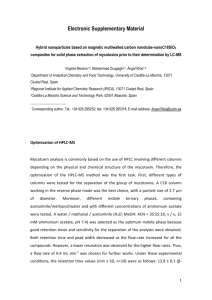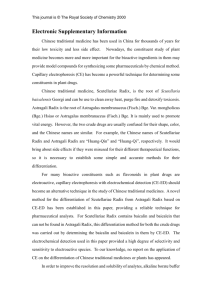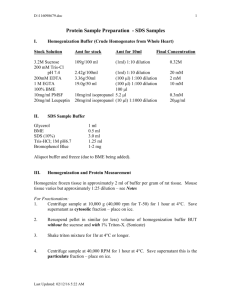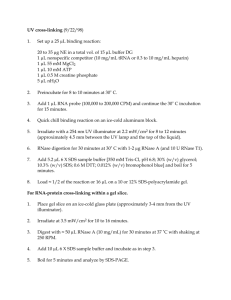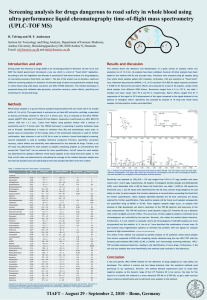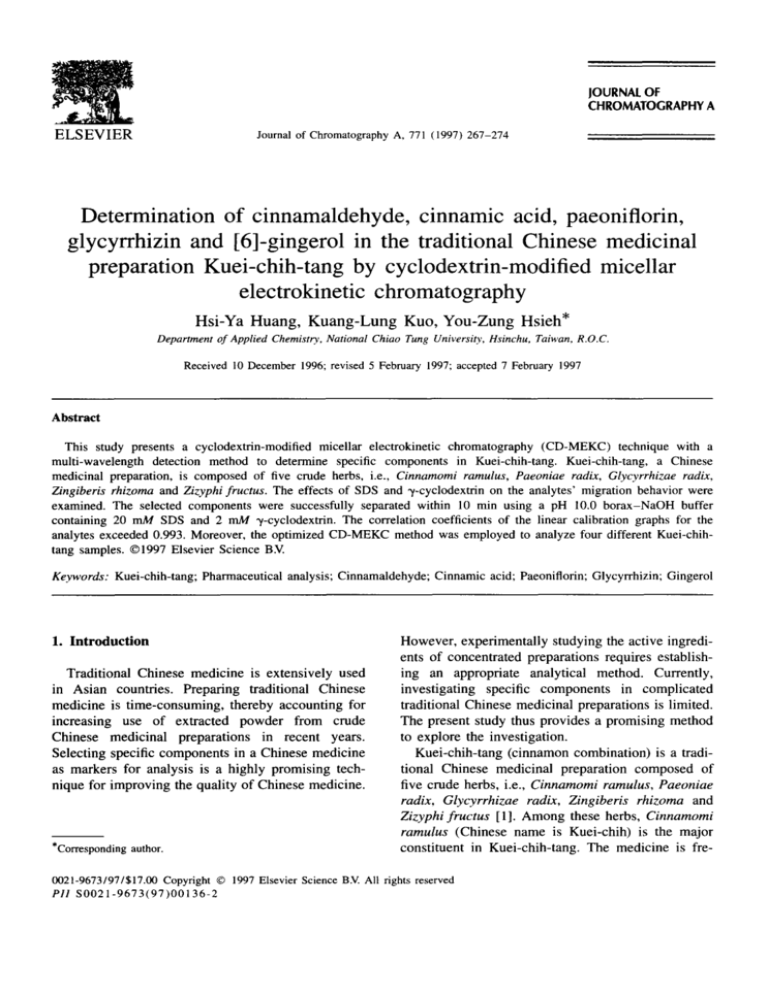
JOURNAL OF
CHROMATOGRAPHY A
Journal of Chromatography A, 771 (1997) 267-274
ELSEVIER
Determination of cinnamaldehyde, cinnamic acid, paeoniflorin,
glycyrrhizin and [6]-gingerol in the traditional Chinese medicinal
preparation Kuei-chih-tang by cyclodextrin-modified micellar
electrokinetic chromatography
Hsi-Ya Huang, Kuang-Lung Kuo, You-Zung Hsieh*
Department of Applied Chemistry, National Chiao Tung University, Hsinchu, Taiwan, R.O.C.
Received 10 December 1996; revised 5 February 1997; accepted 7 February 1997
Abstract
This study presents a cyclodextrin-modified micellar electrokinetic chromatography (CD-MEKC) technique with a
multi-wavelength detection method to determine specific components in Kuei-chih-tang. Kuei-chih-tang, a Chinese
medicinal preparation, is composed of five crude herbs, i.e., Cinnarnomi ramulus, Paeoniae radix, Glycyrrhizae radix,
Zingiberis rhizoma and Zizyphi fructus. The effects of SDS and ~-cyclodextrin on the analytes' migration behavior were
examined. The selected components were successfully separated within 10 min using a pH 10.0 borax-NaOH buffer
containing 20 mM SDS and 2 mM -y-cyclodextrin. The correlation coefficients of the linear calibration graphs for the
analytes exceeded 0.993. Moreover, the optimized CD-MEKC method was employed to analyze four different Kuei-chihtang samples. ©1997 Elsevier Science B.V.
Keywords: Kuei-chih-tang; Pharmaceutical analysis; Cinnamaldehyde; Cinnamic acid; Paeoniflorin; Glycyrrhizin; Gingerol
I. Introduction
Traditional Chinese medicine is extensively used
in Asian countries. Preparing traditional Chinese
medicine is time-consuming, thereby accounting for
increasing use of extracted powder from crude
Chinese medicinal preparations in recent years.
Selecting specific components in a Chinese medicine
as markers for analysis is a highly promising technique for improving the quality of Chinese medicine.
*Corresponding author.
However, experimentally studying the active ingredients of concentrated preparations requires establishing an appropriate analytical method. Currently,
investigating specific components in complicated
traditional Chinese medicinal preparations is limited.
The present study thus provides a promising method
to explore the investigation.
Kuei-chih-tang (cinnamon combination) is a traditional Chinese medicinal preparation composed of
five crude herbs, i.e., Cinnamomi ramulus, Paeoniae
radix, Glycyrrhizae radix, Zingiberis rhizoma and
Zizyphi fructus [1]. Among these herbs, Cinnamomi
ramulus (Chinese name is Kuei-chih) is the major
constituent in Kuei-chih-tang. The medicine is fre-
0021-9673/97/$17.00 Copyright © 1997 Elsevier Science B.V. All rights reserved
PII S002 1-9673(97)00136-2
268
H.-Y. Huang et al. / J. Chromatogr. A 771 (1997) 2 6 7 - 2 7 4
quently used to treat diseases such as the common
cold, abdominal pains owing to chills, neuralgia,
neurasthenia and rheumatic pain. This preparation,
the basis for several other preparations, is very
important in traditional Chinese medicine. Therefore,
its analysis is essential to further understand Kueichih-tang and related medicines as well.
Cinnamaldehyde / cinnamic
acid,
paeoniflorin,
glycyrrhizin and [6]-gingerol are specific components of Cinnamomi ramulus, Paeoniae radix,
Glycyrrhizae radix and Zingiberis rhizoma, respectively [2]. Oleanolic acid, a common component of
sapogenins, was selected herein as a test compound
for Zizyphi fructus because other specific compounds
could not be obtained. Those six compounds were
chosen as analytes in this study.
Thin-layer chromatography (TLC) is the conventional method of analyzing traditional Chinese
medicinal preparations. However, this method can
not be applied to simultaneously analyze several
components in a single crude herb or in a medicinal
preparation composed of several crude materials.
Generally, high-performance liquid chromatography
(HPLC) has been employed to analyze crude herbs
or several marker components in a Chinese medicinal preparation [3-6]. Nevertheless, more than 30
min are generally required for the HPLC method to
analyze a Chinese medicinal preparation [5,6].
Micellar electrokinetic chromatography (MEKC)
is a high-performance capillary electrophoresis (CE)
technique [7-11]. Cyclodextrin-modified MEKC
(CD-MEKC) further enhances the separation efficiency by adding various cyclodextrins in MEKC
buffer. The analytical technique presented herein
possesses similar advantages of CE having a high
separation efficiency, short analysis time and exceptional resolution. Consequently, MEKC has been
employed to analyze Chinese crude herbs and Chinese medicinal preparations [12-14].
In the present study, CD-MEKC was developed to
simultaneously determine selected components of the
five herbs constituted Kuei-chih-tang. The effects of
various separation and buffer conditions on the
analytes' migration behavior were also examined.
The different extraction methods and the variation of
specific component concentrations in four different
Kuei-chih-tang samples were discussed.
2. Experimental
2.1. Apparatus
A Beckman P/ACE 5500 capillary electrophoresis
system (Fullerton, CA, USA) was used. A diodearray detector, which can scan wavelengths ranging
from 190 nm to 600 nm, was connected to the
system. The detection wavelength could also be
programmed to change during the separation process.
The P/ACE instrument was controlled using a personal computer with System Gold software (Beckman Instruments, San Ramon, CA, USA). CE was
performed using a 47 cm (40 cm to detector)×50
~xm I.D. fused-silica capillary tube (Polymicro Technologies, Phoenix, AZ, USA). The capillary column
was assembled in the cartridge format. The temperature of the capillary during electrophoresis was
maintained at 25°C. The applied voltage of the
electrophoresis separation was set at 20 kV. Samples
were pressure injected at 0.034 bar. Data analysis
was performed on System Gold software.
2.2. Chemicals
Sodium dodecyl sulfate (SDS), borax, e~-cyclodextrin and [3-cyclodextrin were all purchased from
Sigma (St. Louis, MO, USA). Cinnamic acid,
glycyrrhizin and ~/-cyclodextrin were purchased from
Nacalai Tesque (Kyoto, Japan). Cinnamaldehyde was
purchased from both Nacalai Tesque and Fluka
(Buchs, Switzerland). [6]-Gingerol and paeoniflorin
were obtained from Yoneyama (Osaka, Japan).
Oleanolic acid was bought from Extrasynthese
(Genay, France). Methanol was bought from Merck
(Darmstadt, Germany). Four samples of concentrated
Kuei-chih-tang manufactured by different Chinese
pharmaceutical companies were purchased from
local drug stores in Taiwan. All other chemicals
were analytical grade and were purchased from
Merck. Water was purified by a Milli-Q water system
(Millipore, Bedford, MA, USA) and filtered through
a 0.22 I~m filter.
2.3. Procedure
Stock solutions (3 mg/ml) of the six analytes
H.-Y. Huang et al. / J. Chromatogr. A 771 (1997) 2 6 7 - 2 7 4
were prepared in methanol. Sample solutions with
various concentrations were prepared by dissolving
the stock solution to a methanol-water solution (7:3,
v/v). Electrophoresis buffers (borax-NaOH buffer)
were prepared by mixing 0.1 M borax and 0.1 M
sodium hydroxide in deionized water. Each of the
commercial, concentrated Kuei-chih-tang samples
were accurately weighted at 2.0 g. The concentrated
samples were extracted by 20 ml methanol-water
solution (7:3, v/v) or pure methanol for 15 rain in an
ultrasonic bath. The extracted solution was then
filtered through a filter paper. The extraction and
filtration procedures were repeated three times. A
total of 60 ml extracted solution was concentrated to
a final volume 4.0 ml and was ready for analysis.
The extraction recovery study followed the same
procedure described above.
3. Results and discussion
In the present study, six specific compounds were
selected as the target analytes, i.e., cinnamic acid,
cinnamaldehyde, [6]-gingerol, glycyrrhizin, oleanolic
acid and paeoniflorin. Fig. 1 depicts their structures.
Those structures markedly vary and their maximum
absorbance wavelengths differ in the UV-Vis region.
The maximum absorbance wavelengths of paeoniflorin, oleanolic acid and [6]-gingerol were at 200 nm.
Glycyrrhizin and cinnamaldehyde had maximum
absorbances at 260 nm and 295 nm, respectively.
Cinnamic acid had two similar intensity absorbances
around 210 nm and 270 nm. Because of the differences in absorbance wavelengths, the use of a diodearray detector for multiwavelength detection is
necessary.
Several buffer systems, such as phosphate buffer
(pH 7.0 or pH 8.0) and borate buffer (pH 9.0 or pH
10.0), were preliminarily tested for separating the
analytes. Fig. 2 illustrates the influence of pH values
on the separation of selected compounds. Cinnamic
acid and glycyrrhizin could be resolved from pH 7.0
to pH 10.0. The migration time of oleanolic acid
dramatically changed when the pH value exceeded
8.0 because more oleanolic acid molecules were
dissociated. Thus, a good separation efficiency and
resolution for oleanolic acid could be achieved in a
269
H
paeoniflorin
~
GIcAGlcA-~o~-,~I
~
COOH
oleanolic acid
COOH
,./CHO
cinnamaldehyde
glycyrrhizin
~
cinnamic acid
OOH
[6]-gingerol
Fig. 1. Molecular structures of the six analytes.
pH 9.0 or pH 10.0 buffer. However, cinnamaldehyde, [6]-gingerol and paeoniflorin had similar
velocities as the electroosmotic flow velocities at
each of the given pH values. Therefore, the three
analytes could not be satisfactorily resolved in those
pH values. Since the best separation efficiencies and
resolutions for the analytes were achieved at pH
10.0, modifiers were added to the pH 10.0 borate
buffer for subsequent analysis.
3.1. Effects of SDS on the separation
Various concentrations of SDS, ranging from 10
mM to 60 mM, were added to the pH 10.0 borate
buffer. The migration behavior of cinnamaldehyde,
[6]-gingerol and oleanolic acid were significantly
altered when the running buffer contained SDS.
Specifically, their migration times increased with
increasing SDS concentration. Experimental results
thus indicated that those three compounds strongly
interacted with SDS micelles. Fig. 3 depicts two
electropherograms obtained from two different buffer
solutions. One of the running buffers contained 20
mM SDS (Fig. 3b) and the other did not contain SDS
270
H.-Y. Huang et al. / J. Chromatogr. A 771 (1997) 267-274
(a)
65
5
5.5
4
~
s
['~ 4 5
<
(b)
5
2
O.Ol U
3.5
6
1
4
2.5
6.5
I
7,5
I
8.5
pH Value
i
9,5
i
2
105
Fig. 2. Effects of buffer pH values on the analytes' migration
times, l=Paeoniflorin; 2=oleanolic acid; 3=glycyrrhizin; 4=
cinnamaldehyde; 5=cinnamic acid; 6=[61-gingerol. Conditions:
capillary, 47 cm (40 cm to detector)×50 ~m I.D.; applied voltage,
20 kV; detection wavelength, 200 nm; column temperature, 25°C.
(Fig. 3a). As those results indicate, adding SDS
micelles significantly decreased the migration velocities of cinnamaldehyde, [6]-gingerol and oleanolic
acid. Such a decrease is due to the compounds'
hydrophobic properties. In contrast with the strong
influence of SDS micelles on the migration behaviors
of those three compounds, the migration velocities of
paeoniflorin, glycyrrhizin and cinnamic acid altered
only slightly in the SDS buffer. This phenomenon
can be accounted for by the molecular structure of
the compound. More specifically, the latter three
compounds are too polar to interact with SDS.
As Fig. 3a reveals, the cinnamaldehyde signal was
extremely weak due to the simultaneous emergence
of the electroosmotic flow. According to experimental results, cinnamaldehyde had only one peak at
various pH values (ranging from pH 7.0 to pH 10.0)
of the running buffer without SDS. However, as Fig.
3b shows, the cinnamaldehyde peak split into two
unresolved peaks as the buffer contained 20 mM
SDS. Interestingly, the unresolved two peaks had
I
4
I
6
I
8
I
10
12
Time(rain)
Fig. 3. Electropherogramsof the analytes in (a) pH 10.0 boraxNaOH buffer and (b) pH 10.0 borax-NaOH buffer containing 20
mM SDS. Other conditions as in Fig. 2.
identical UV-Vis spectra. Also, cinnamaldehyde
obtained from two different manufacturers had
identical results. Since both manufacturers claimed
that the cinnamaldehyde's purity exceeded 98%, the
split peaks are not likely caused by the chemicals'
impurity. In contrast, the split peaks are more likely
due to the fact that cinnamaldehyde can interact
either with SDS micelles or SDS monomers, thereby
yielding different migration velocities. Notably the
splitting condition decreased with an increasing SDS
concentration. The unresolved two peaks became one
peak again after addition of more than 50 mM SDS
to the running buffer.
Fig. 3b indicated that all six analytes were
resolved within 11 min. However, as shown in this
figure, the peaks of glycyrrhizin, cinnamic acid and
cinnamaldehyde were close. To easily identify the
three compounds in actual samples, the separation
buffer must be further modified to enhance the
resolution of the analytes. Experimental results revealed that the separation time became longer with
an increasing SDS concentration, but not all of the
separation resolutions increased with an increasing
SDS concentration. Therefore, we selected a buffer
H.-Y. Huang et al. I J. Chromatogr. A 771 (1997) 267-274
containing 20 mM SDS to enhance the resolution
and minimize the separation time.
271
105
3.2. Effects of cyclodextrins on the separation
The migration times of glycyrrhizin were shortened as 13-cyclodextrin or ~/-cyclodextrin was added
to a 20 mM SDS buffer. Whereas the migration times
of glycyrrhizin exhibited no significant changes
when the buffer contained ct-cyclodextrin. In addition, the migration times of oleanolic acid only
significantly altered in a ~/-cyclodextrin modified
buffer. From those results, we can infer that those
two analytes can form inclusion complexes with
~/-cyclodextrin. The fact that size-matching between
cyclodextrin and analytes plays a prominent role in
forming inclusion complexes suggests that only ~tcyclodextrin is sufficiently large for glycyrrhizin and
oleanolic acid. Therefore, "y-cyclodextrin was added
into the borate buffer containing 20 mM SDS to
enhance the resolution.
For the six analytes' migration behavior, Fig. 4
shows the effects of adding various concentrations of
~/-cyclodextrin to a 20 mM SDS buffer. According to
this figure, the migration times of oleanolic acid and
glycyrrhizin markedly changed. More specifically,
oleanolic acids migration time shortened from 10.5
min to 3.7 min, even when only 0.5 mM ~/-cyclodextrin was added. This enormous decrease in migration time indicated that oleanolic acid had the highest
degree of inclusion complexation with ~/-cyclodextrin among the analytes. Fig. 3b reveals that
oleanolic acid strongly interacted with SDS micelles.
However, that interaction became weak with the
presence of ~/-cyclodextrin in the buffer. In the case
of the other four analytes, paeoniflorin, cinnamic
acid, cinnamaldehyde and [6]-gingerol, adding ~/cyclodextrin in the buffer only slightly affected
them.
The migration sequence of the analytes remained
the same while adding 0.5 mM to 4 mM ~/-cyclodextrin to the buffer. The migration times of
glycyrrhizin and oleanolic acid were only slightly
influenced when ~/-cyclodextrin concentration exceeded 2 mM. In addition, the resolution between
cinnamaldehyde and glycyrrhizin decreased as the
~/-cyclodextrin concentration exceeded 2 mM. Consequently, the optimum condition for separating the
6
5
6:
I
4,4
3
2
2.5
I
0
~
I
1
2
3
4
gamma-Cyclodcxtrin Concentration (raM)
5
Fig. 4. Effects of 3,-cyclodextrin concentrations on the analytes'
migration times. Conditions: separation solution, ~/-cyclodextrin in
38 mM b o r a x - N a O H buffer containing 20 m M SDS, pH 10.0.
Other conditions as in Fig. 2.
six analytes could be achieved with the pH 10.0
borate buffer containing 20 mM SDS and 2 mM
~/-cyclodextrin. Fig. 5 depicts the separation of the
target analytes in optimum conditions. Resolutions
among glycyrrhizin, cinnamaldehyde and cinnamic
acid were more enhanced under this condition than
with no ~/-cyclodextrin in the buffer. Also, the entire
separation was completed within 10 min.
Table 1 lists the average migration times, reproducibilities, correlation coefficients of linear calibration graphs and limits of detection for the six
analytes in optimum conditions. The relative standard deviations (R.S.D.s) of the migration times were
less than 0.42%. The concentration ranges for calibration graphs were 105-420 Ixg/ml for paeoniflorin, 150-600 l~g/ml for oleanolic acid, 200-800
ixg/ml for glycyrrhizin, 40-160 i~g/ml for cinnamaldehyde, 8-32 I~g/ml for cinnamic acid and
10-40 ixg/ml for [6]-gingerol. The peak area of the
electropherogram was employed for quantitation of
the analytes. The correlation coefficients of the
272
H.-Y. Huang et al. / J. Chromatogr. A 771 (1997) 267-274
R
I
0005 AU
002 AU
1
1
g
g
4
ca
g
n
<
<
4
5
_J
i
0
2
4
I
I
6
8
M-,---.-
I
10
2
Time (min)
I
4
6
I
8
10
12
Time (min)
Fig. 5. Separation of specific analytes in the optimum condition.
Conditions: separation solution, 38 mM borax-NaOH buffer
containing 20 mM SDS and 2 mM ~/-cyclodextrin, pH 10.0;
pressure injection, 3 s. Other conditions as in Fig. 2.
Fig. 6. Separation of Kuei-chih-tang by CD-MEKC. Conditions:
detection wavelength: 200 nm (before 4.0 min), 270 nm (after 4.0
min), 295 nm (after 4.8 min), 270 nm (after 5.3 min) and 200 nm
(after 8.0 min). Conditions as in Fig. 5.
calibration graphs w e r e greater than 0.993. In addition, the limits o f detection for those analytes ranged
f r o m 0.77 to 28.43 }xg/ml. O u r e x p e r i m e n t a l results
thus confirm that the C D - M E K C m e t h o d definitely
possesses the advantages o f high precision, high
resolution and short analysis t i m e for analyzing those
analytes.
3.3. Extraction and determination o f specific
components in Kuei-chih-tang
Fig. 6 shows the e l e c t r o p h e r o g r a m o f Kuei-chihtang. B e c a u s e those analytes had m a x i m u m absorbances at different wavelengths, the detection w a v e length was p r o g r a m m e d to c h a n g e during the sepa-
Table 1
Average migration times, relative standard deviations, correlation coefficients of calibration graphs and limits of detection of six analytes
Analyte
Migration time (min)~
R.S.D. (%)4
Correlation coefficient
of calibration graph (r)
Limit of detection
( Ixg/ ml )
Paeoniflorin
Oleanolic acid
Glycyrrhizin
Cinnamaldehyde
Cinnamic acid
[6]-Gingerol
3.49
3.65
4.56
4.86
5.43
8.82
0.31
0.36
0.42
0.32
0.27
0.25
0.999
0.993
0.999
0.997
0.999
0.995
6.97
28.43
15.01
2.83
1.46
0.77
n=20.
H,-Y. Huang et al. / J. Chromatogr. A 771 (1997) 2 6 7 - 2 7 4
Table 2
The extraction recoveries of the analytes spiked in Kuei-chih-tang
Analyte
Recovery (%)a
R.S,D. (%)
Paeoniflorin
Oleanolic acid
Glycyrrhizin
Cinnamaldehyde
Cinnamic acid
[6]-Gingerol
99.7
99.2
85.3
90,1
93.6
94.4
2.79
1.21
3.33
3.88
3.49
4.66
Values are means of triplicate determinations.
ration of Kuei-chih-tang. The detection wavelength
was initially set at 200 nm, then was changed to 270
nm at 4.0 min, to 295 nm at 4.8 min, to 270 nm at
5.3 min and to 200 nm at 8.0 min. As shown in Fig.
6, more than ten peaks appeared in the electropherogram. However, paeoniflorin, glycyrrhizin,
cinnamaldehyde, cinnamic acid and [6]-gingerol
were adequately resolved from other unknown compounds and could be clearly identified.
The specific components in Kuei-chih-tang samples were identified by comparing both the migration
times and the UV spectra of standards with those in
actual samples. The analytes were further confirmed
by spiking standards in actual samples. The specific
components can be adequately identified through
those processes.
Next, the influences of extraction solutions on the
extraction of Kuei-chih-tang were investigated because the six analytes had different solubilities in the
extraction solutions. The methanol-water solution
273
and the methanol solution were employed as extraction solutions in this study. The methanol-water
solution was an appropriate extraction solution for all
the analytes except cinnamaldehyde. The cinnamaldehyde extracted by methanol exhibited a significantly larger signal than when extracted by the
methanol-water solution. This difference implies
that the former has a better solubility and extraction
power than the latter for cinnamaldehyde. Therefore,
methanol was used as the extraction solvent for
quantitation of cinnamaldehyde. The six analytes
were successfully extracted by methanol-water or
methanol solution with ultrasonic bath. Table 2
presents the recoveries of standards spiked in Kueichih-tang. The recoveries of the analytes ranged
from 85.3% to 99.7%. The R.S.D.s of those recoveries were smaller than 5.0%. The results demonstrated that the extraction method was adequate for
the analysis.
The comparisons of six analytes in four Kuei-chih°
tang samples manufactured by different companies
are shown in Table 3. Notably, oleanolic acid could
not be found in Kuei-chih-tang. As shown in Table
3, the amounts of each analyte in these four different
samples were quite different. The large variation in
the specific component concentrations is probably
due to either different manufacturing processes or
different sources of crude herbs. The relatively large
R.S.D.s of actual samples compared with standards is
probably due to the complexity of the Chinese
medicinal preparations and the heterogeneity of the
concentrated powder. However, the R.S.D. values
Table 3
Contents of specific components in four different Kuei-chih-tang samples
Analyte
Paeoniflorin
Oleanolic acid
Glycyrrhizin
Cinnamaldehyde
Cinnamic acid
[6]-Gingerol
n=3.
Not detected.
Sample I a
Sample 2"
Sample 3 a
Sample 4 a
Mean
R.S.D.
Mean
R.S.D.
Mean
R.S.D.
Mean
R.S.D.
(mg/g)
(%)
(mg/g)
(%)
(mg/g)
(%)
(mg/g)
(%)
18.09
_b
13.87
3.04
0.27
0,036
0,88
19.23
_~
13.43
0.83
0.19
0.108
1.93
10.14
_h
8.09
0.39
0.32
0.008
0,23
3.99
_b
6.56
0.56
0.22
0.026
2.62
1,47
5.33
3.71
1.89
3.82
3.88
3.01
1.43
3.09
5,38
6.17
6.35
1.94
4.36
4.82
5.35
274
H.-Y. Huang et al. / J. Chromatogr. A 771 (1997) 267-274
were in the same range as those obtained from HPLC
or MEKC analysis of the Chinese medicinal preparations [5,6,12].
Our results demonstrated that the amount of [6]gingerol in Kuei-chih-tang was quite low. Since
[6]-gingerol is a specific component in Zingiberis
rhizoma, the small quantity of [6]-gingerol is probably due to the fact that the concentration of [6]gingerol is markedly lower than other analytes. As
mentioned earlier, oleanolic acid could not be found
in Kuei-chih-tang. Thus, oleanolic acid was tested
for a in a preparation containing only Zizyphi
fructus. However, no oleanolic acid peak appeared.
Its absence suggests that oleanolic acid is not a
specific component of extracted Zizyphi fructus.
Therefore, searching for other specific components
of Zizyphi fructus is necessary for future analysis.
Simultaneously determining specific components
of crude herbs constituting Chinese medicine is
difficult because of the complexity of the matrix and
the concentration differences among various specific
components. Compared with the conventional TLC
method, the five specific components of Kuei-chihtang could be simultaneously determined by the
CD-MEKC method. Therefore, the analysis method
introduced herein is quite appropriate for analyzing
Kuei-chih-tang. This investigation not only provides
quantitative information of Kuei-chih-tang, but analytical information as well to improve its preparation
process. Furthermore, the MEKC technique can be
employed to analyze other traditional Chinese
medicinal preparations, shedding further light into
the extremely complex preparation of Chinese medicine.
4. Conclusion
The present study successfully develops a CDMEKC method to analyze specific components in
Kuei-chih-tang. Those analytes can be completely
separated with the borate buffer containing 20 mM
SDS and 2 mM ~/-cyclodextrin. Specific components
in Kuei-chih-tang can be determined by the CDMEKC method coupled with a relatively simple and
efficient extraction method. Results of this investigation provide valuable information regarding actual components in concentrated Chinese medicine.
The method serves as a highly promising alternative
for quantitatively analyzing concentrated Chinese
medicinal preparations as well. Further study in this
area is underway.
Acknowledgments
This research was supported by Grand NSC 862113-M-009-016 from the National Science Council
of Taiwan, R.O.C.
References
[1] H.-Y. Hsu and C.-S. Hsu, Commonly Used Chinese Herb
Formulas with Illustrations, Oriental Healing Arts Institute,
Long Beach, 1990.
[2] The Analysis Methods for Chinese Medicine, Vols. 7 and 8,
National Laboratories of Foods and Drugs, Department of
Health, Taipei, 1995.
[3] K. Sagara, T. Oshima, T. Yoshida, Y.-Y. Tong, G. Zhang and
Y.-H. Chen, J. Chromatogr., 409 (1987) 365.
[4] K. Yoneda, E. Yamagata and M. Tsujimura, Shoyakugaku
Zasshi, 45 (1991) 220.
[5l Y.-C. Lee, C.-Y. Huang, K.-C. Wen and T.-T. Suen, J.
Chromatogr. A, 660 (1994) 299.
[6] Y.-C. Lee, C.-Y. Huang, K.-C. Wen and T.-T. Suen, J.
Chromatogr. A, 692 (1995) 137.
[7] S. Terabe, K. Otsuka and T. Ando, Anal. Chem., 57 (1985)
834.
[8] M.J. Sepaniak, A.C. Powell, D.F. Swaile and R.O. Cole, in
P.D. Grossman and J.C. Colburn (Editors), Capillary Electrophoresis--Theory and Practice, Academic Press, San Diego,
CA, 1992, Ch. 6.
[9] F. Foret, L. Kriwinkov~i and P. Bocek, Capillary Zone
Electrophoresis, VCH, Weinheim, 1993.
ll0l S.F.Y. Li, Capillary Electrophoresis, Elsevier, Amsterdam,
1993.
[11] N.A. Guzman (Editor), Capillary Electropboresis Technology, Marcel Dekker, New York, 1993.
[12] Z. Iwagami, Y. Sawabe and I. Nakagawa, Shoyakugaku
Zasshi, 46 (1992) 49.
[13] Y.-Z. Hsieh and H.-Y. Huang, J. Chromatogr. A, 759 (1997)
193.
[14] S.-J. Sheu and C.-F. Lu, J. High Resolut. Chromatogr., 18
(1995) 269.


